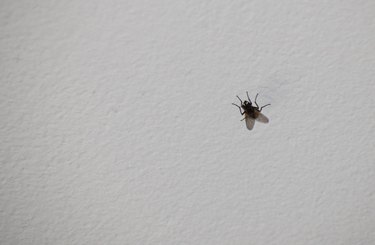
Pest control has been the bane of many a homeowner's existence, and while a single insect or two can be annoying, groups of tiny, crawling bugs on the walls and ceilings often indicate a much larger problem. What are these insects, how much of a threat do they pose to your property or family and how do you get rid of them? These are just a few of the questions running through your mind when you spot a teeming mass of tiny black bugs.
Tiny Crawling Bugs on Walls and Ceilings
Video of the Day
There are three basic approaches to pest control, and while you can attempt each one as a partial solution to the problem, using all three together is your best bet to completely solve your infestation. The first and most instinctive approach is to kill the pests you can see. Second, you will want to eliminate eggs and nests to prevent population growth and gradually diminish the number of bugs. Finally, prevent future intrusions and infestations.
Video of the Day
Of course, identifying which bugs you are dealing with is a critical first step. If they're small enough, most black bugs look the same. A magnifying glass, the zoom on your phone camera or distinct behavioral traits can help you distinguish between fleas, book lice and gnats among other potential pests.
First, pay attention to the insects' movements. Do they fly or only crawl? Do the bugs jump? Differentiating between several small indoor pests may depend on where you find them. Pests that feed on mold are almost never a threat to people or structures, while pests that are more dangerous to humans will be found in clothing and bedding. Carpet beetles are an exception, existing in stored clothing, bedding and at the edges of in-use carpets to consume animal-produced keratin.
Additional Bug Identification Techniques
Next, look at the shape of the insect bodies as seen from above. Can you distinguish the head from the rest of the body? Are they rounded, or do they have an elongated body? Do they have wings whether or not they fly?
Some beetles have wings or wing pads but cannot actually fly. "Bat bugs" have wing pads but do not fly. While they will feed on the blood of any mammal, it is significantly easier to get rid of them, and they do not have a history of causing infections or illness.
Spider beetles look similar to fleas and ticks, but they don't jump. Fleas, however, will be much hairier. Ticks have larger, soft bodies.
The Three Approaches of Pest Management
Reducing the extant population of a house pest manages the symptom of an infestation. Hanging a fly strip or placing a glue trap reduces the adult population of house pests but doesn't address the issue of where they're coming from. Culling visible pests definitely reduces breeding pairs and the stress you feel from seeing the pests.
Fogging bombs, slow-acting poisons and even professional pest removal services can address a central nest, killing queens and neutralizing unhatched eggs to prevent the current population from growing, but it doesn't address how the pests came into your house in the first place.
Repairing leaky pipes, sealing cracks in the foundation or around entrances and maintaining a clean kitchen and trash area can all contribute to denying pests entry to your home, but some will inevitably find their way inside. Some insects, such as fruit or fungus gnats, cannot be completely prevented. You can even accidentally bring home bugs in food from the store. At that point, you'll need to employ one or both of the other pest management approaches to manage and eliminate the insects plaguing your home.